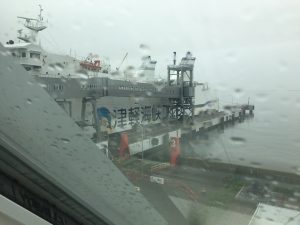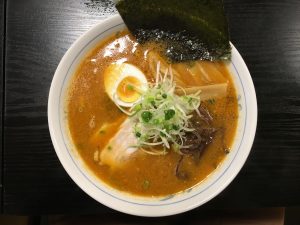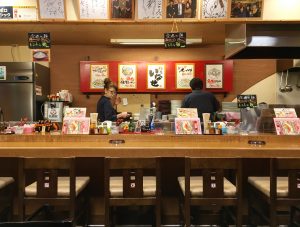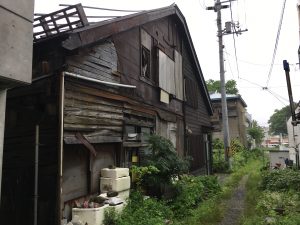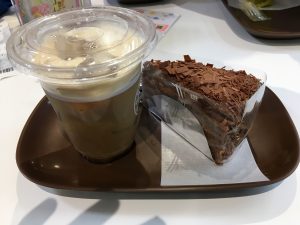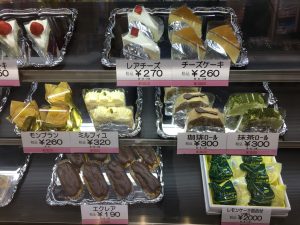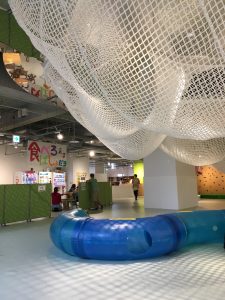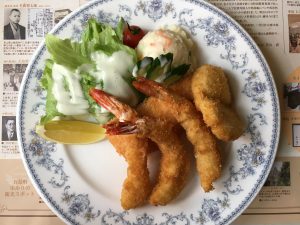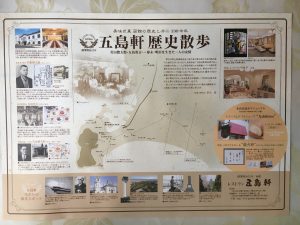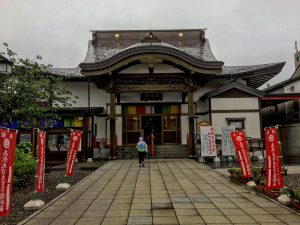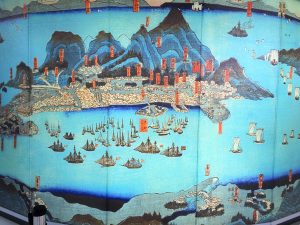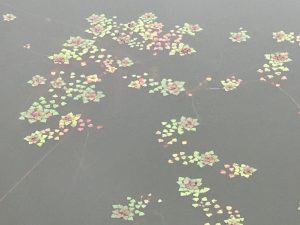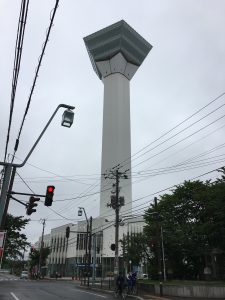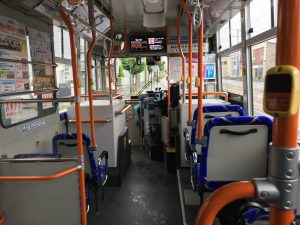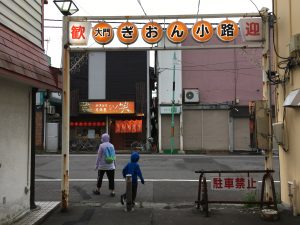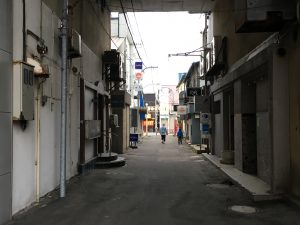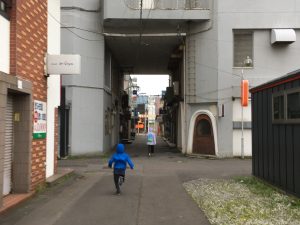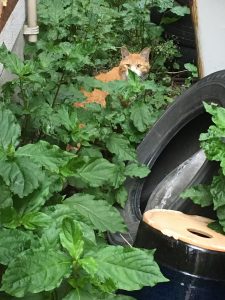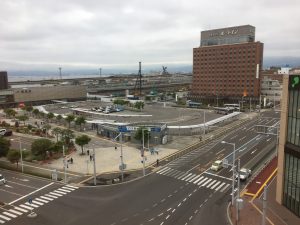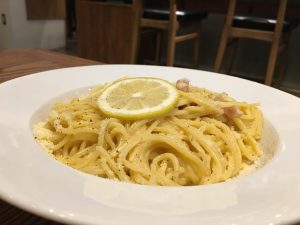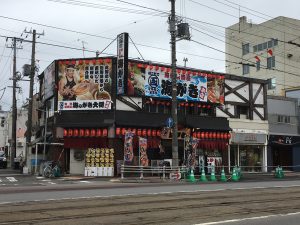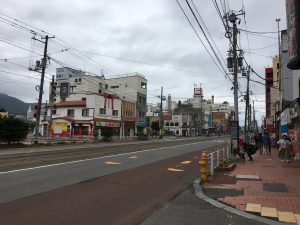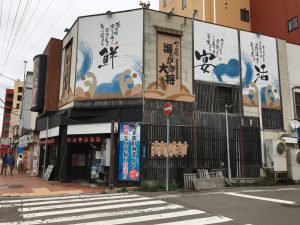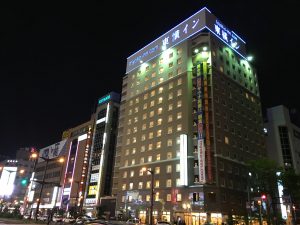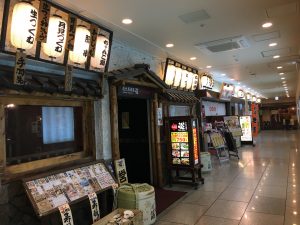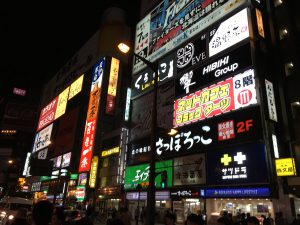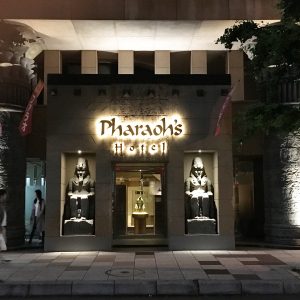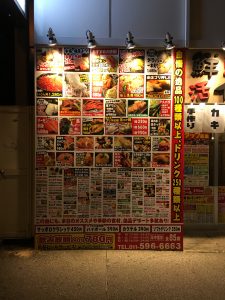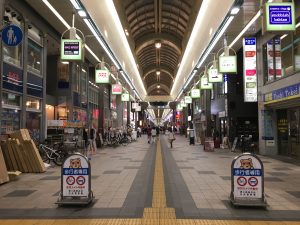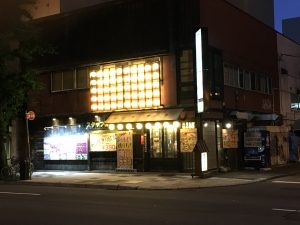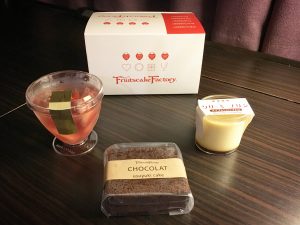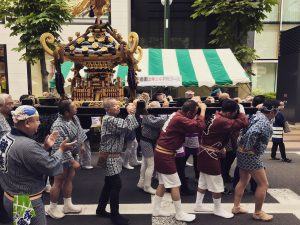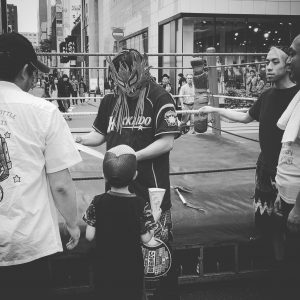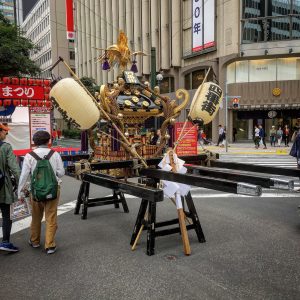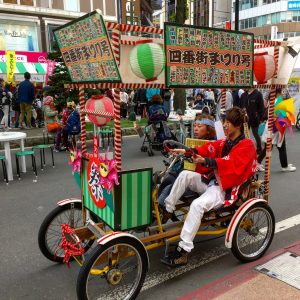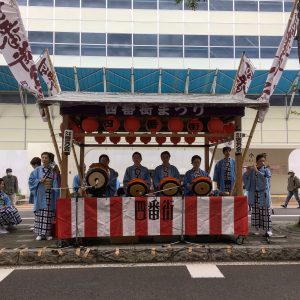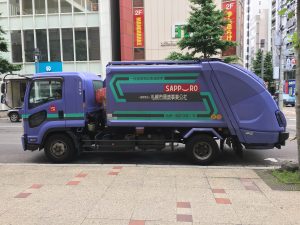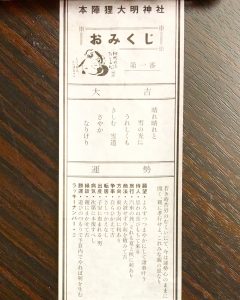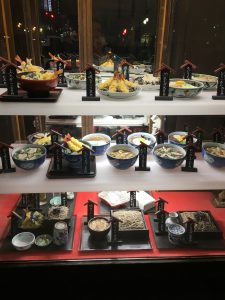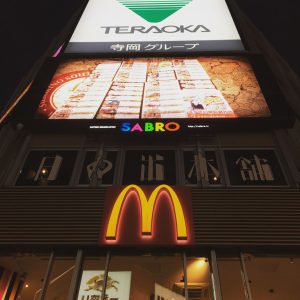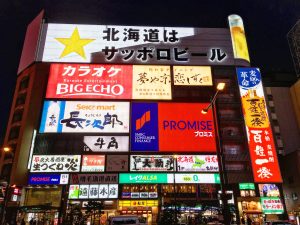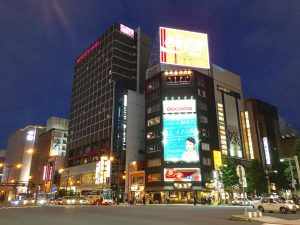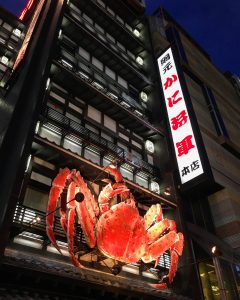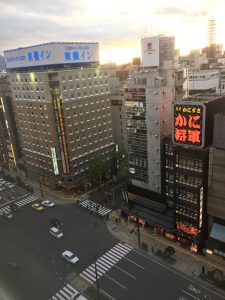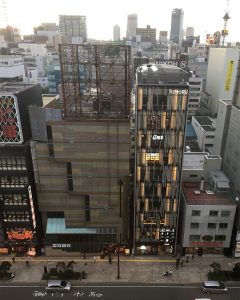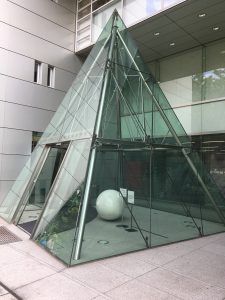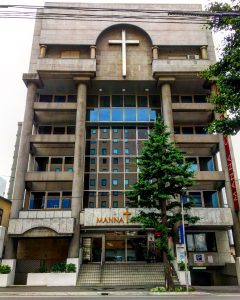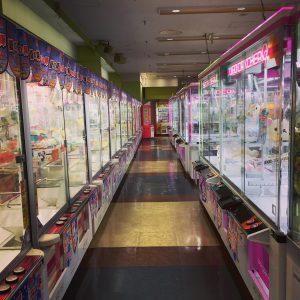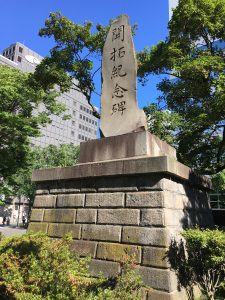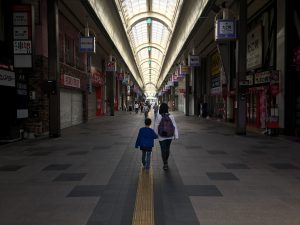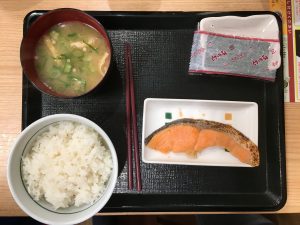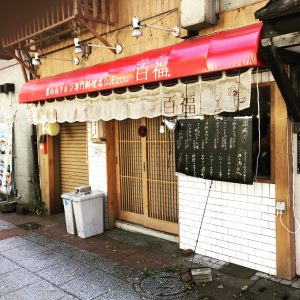This article is part of the series on my July 2018 trip to Japan. Please see the table of contents page for other articles in this series as they are posted.
None of us had been to northeast Japan before, so we decided to spend a good portion of this trip in the cities of Sapporo (札幌) and Hakodate (函館) in Hokkaido (北海道), Japan’s second largest yet least developed island.
While in Sapporo, we stayed in hotel Mercure, which was small but right in the middle of a bustling entertainment district downtown, something like a cross between Tokyo and Broadway. Within walking distance were countless restaurants, coffee shops, bars, and various other stores. One of the most memorable was a crab restaurant that had a large-scale model of a red crab above the entrance––a somehow eerie sight when lit at night.
One of the more interesting things we did in Sapporo was attend the yonbangai matsuri (四番街祭り), a festival held during the day in the streets of the heart of downtown Sapporo. There were typical children’s activities like kingyo-sukui (金魚すくい, goldfish catching), shateki (射的, a shooting game), and some typical foods like kaki-goori (かき氷、shaved ice). Of course, no festival would be complete without the carrying of an omikoshi (お神輿, portable shrine) by a crowd through the streets. There was also other entertainment like a boxing (wrestling?) match on a stage and a music performance with traditional instruments such as taiko drums and a flute. We left after only two hours, but it was nevertheless a fun highlight to our stay in Sapporo.
Sometime near the middle of the festival we stopped by a coffee shop on the same street, an underground jazz-style cafe with a unique atmosphere. Unfortunately, because of the smoke we decided to get a drink to go, but the iced latte was great!
One of my favorite places in Sapporo was tanuki kouji shoutengai (狸小路商店街, Racoon Dog Lane Arcade), a covered shopping area that ran for many blocks. There was a nice mix of shops here including fine restaurants, an electronics store (selling individual electronics parts like Radio Shack), and clothing shops. In the midst of the arcade is honjin tanuki daimyou jinja(本陣狸大明神社), a tiny shrine dedicated to––you guessed it––raccoon dogs.
Overall the food in Sapporo was great, though we did have one bad experience. We entered a ramen shop, and while passing through the door noticed a foul odor, something that can only described as trash. However, there were a few customers inside eating like it was nothing, and one of the waiters casually acknowledged there was a smell. So we hoped it was just the smell of trash cans outside the entrance and decided to enter and order some ramen. Unfortunately, the smell didn’t go away and the ramen was pretty mediocre; the nori was so hard I had trouble eating it, and the broth wasn’t anything to write home about. Even after leaving the restaurant I felt like that smell was stuck in my system for the next few hours. I won’t mention the name of the restaurant (hopefully they clean up their act), but if you happen to discover an unpleasant scent at the entrance of a restaurant, think twice about entering!
While in Sapporo, we also visited a manga cafe. I had been to one many years back but wanted to go again with my family. The signage outside advertised Playstation games, and since I don’t own a PS3 or PS4 I was hoping to try out some of the latest games. In case you haven’t been to a manga cafe before, for a flat hourly fee they let you read as much manga as you want, and enjoy (non-alcoholic) drinks––though the latter is generally low-quality like fountain drinks. We got a small room with two sofas, a TV, and even a PC. While my wife read through a few manga books I found the Playstation, but was disappointed to see it was only a PS2. To make matters worse, when I searched the cafe I couldn’t find games anywhere. So I asked the cafe attendant and was told they don’t rent out (貸し出し, kashidashi) games in the cafe, you have to bring your own. Since my manga reading speed is a bit slow, that left only the PC. Unfortunately, that was not set up for many games except simple ones like solitaire and chess, and a bunch of online games––many that required registration. There was little for our son to do so we ended up leaving after only an hour. But if you enjoy manga and want to relax in a cool, quiet space, I would still recommend visiting a manga cafe at least once.
Looking back on our few days in Sapporo, there isn’t much else we did except to explore the downtown cityscape. While it was a lot of fun, the atmosphere was similar to Tokyo in many respects. While we were there I read in a magazine that Sapporo is Japan’s second largest hankagai (繁華街, busy downtown area), only topped by Tokyo itself. Unless you know Tokyo quite well, perhaps lived there for several months or longer, you may not be able to tell them apart. But regardless, if you are looking for a thriving nightlife, Sapporo place is hard to beat. I managed to slip out of my hotel at night for a few minutes just to take pictures and get a small sample of what it was like.
Next we moved onto Hakodate and for a few days stayed in Paco hotel, which sported a nice onsen (温泉), bath facilities where the water is taken from a natural hot spring.
The Hakodate train station we got off at was quite modern, but as soon as you leave the station and start to head into the city it becomes apparent this is no bustling Tokyo or Sapporo––while there are no rolling rice fields like you see in the countryside, Hakodate has a definite ‘small town’ feel, and the farther away you get from the station the more rural it gets. The exception is, of course, a modern-looking McDonalds that we stumbled across in the middle of the city.
For example, the buildings are farther apart than in Tokyo, and there aren’t as many multiple-story shops. There are also more rundown, or at least less maintained areas. We didn’t come across any big crowds in the noon or evening either. When exploring the area we came across a fish market with more types of raw fish than I can imagine, and in the same building was a small ramen shop called Inase. I got a basic shoyu (醤油, soy sauce) ramen and my wife got a seafood ramen, with fresh scallops (帆立, hotate), one of the specialties of that area. I remember struggling to read the words sappari (light flavor) and kotteri (heavy flavor), written in hiragana with a fancy font. My shoyu ramen was packed with all sorts of vegetables and offered a light, but complex flavor that must have been nutrient-rich. The waitress/chef there was very nice to my son so at the end we took a picture of them together.
During our stay in Hakodate we took a bus to visit the nearby goryoukaku (五稜郭) historical site, an Edo-period fort built over 150 years ago in the shape of a perfectly shaped 5-point star. There is an observation tower where you can view this amazing structure, as well as the rest of the surrounding area, for a pretty reasonable price (900 yen for adults and half that for children). There are also several gift shops with unique omiyage (お土産, souvenir) like katana-shaped chopsticks; the larger shop of the bottom floor can be accessed without paying the entrance fee. On the observation deck there is a model of the fort with information of what purposes the various areas served. While I am not a huge history buff this was still an interesting experience. You can also walk around on the grounds itself––though I am not sure to what extent––though we just took a stroll around the entrance without going inside. We wanted to go up to the observation tower first and beat the rush, though in the end there were not that many other people and once we were done observing (and shopping) we went to find food. On a translation note, I have seen this place referred to as a ‘castle’ or ‘citadel’, but I think ‘fort’ is a better fit.
Another place of note is Hakodate Kids Plaza, which contains a giant raised net for kids to crawl around in, a climbing wall, a little bouncy house, and a smaller cushioned area for younger children. On an adjacent floor is Hakodate Miraikan that has a space for doing puzzles as well as a large interactive screen that shows things such as a massive whale swimming by. We got bored of the Miraikan in only 15-20 minutes, but you can get tickets to both of these attractions and save money.
A final stop of interest in the city was gotouken (五島軒), an English-themed restaurant that has been around since 1879 residing inside of a stylish hotel. When we finally found the hotel after wandering around in the rain for far too long (blame the finicky iPhone GPS), we were asked to wait in a special waiting room that had works of art such as paintings and statues. The food was great (I had a mix of fried food including shrimp, and my wife a seafood curry plate) and the service was excellent. I remember that soon after we ordered, someone who looked like a manager came to our table and politely said it would take some time to prepare the food. To our surprise, it came out only 5-10 minutes later.
Of all the places we visited on our trip, Hakodate was the most unique, special place whose small-town atmosphere we really enjoyed. Though it can’t compare to a metropolis like Tokyo or Sapporo in terms of things to do, the very lack of crowds and cramped spaces helps create its sleepy, rural charm.
Overall, while Hokkaido was a great experience, if we go back I think we will want to explore more places like the rural Hakodate and less like the bustling Sapporo. In travel photos of Hokkaido you often see wide fields of lavender, and while I’ve seen similar natural beauty in Oregon, Hokkaido surely has much great natural scenery to enjoy.
I’ve included around 50 of my pictures from the trip below to give you a feel for our trip.
(Back to the table of contents page for this series)
